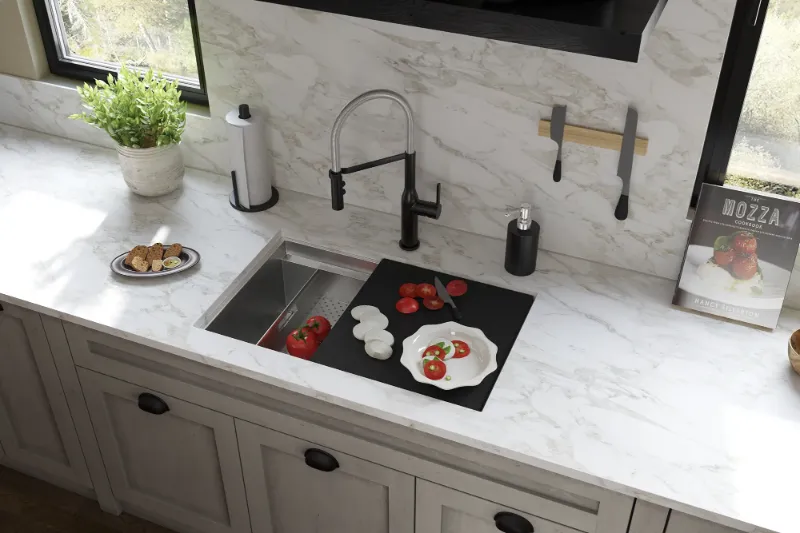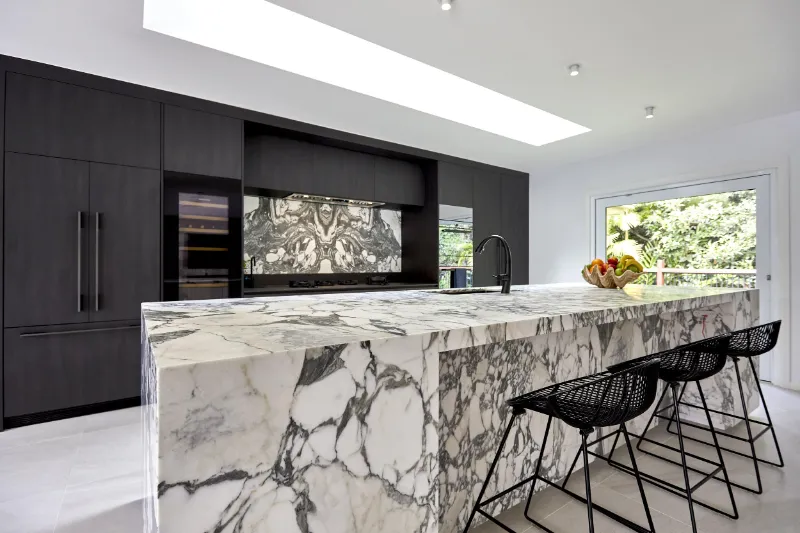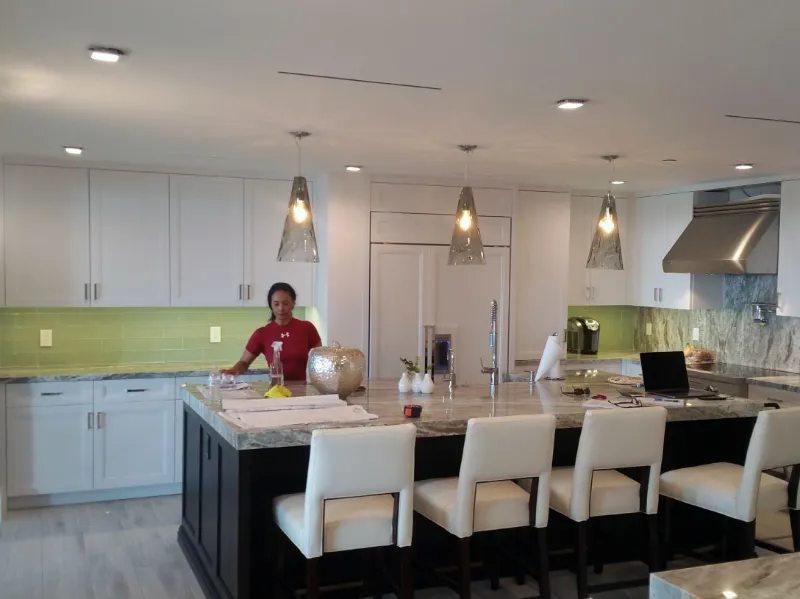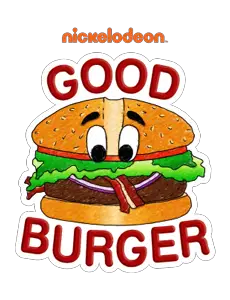How many circuits for kitchen? Planning on renovating your kitchen? One of the most important things to consider when renovating your kitchen is how many circuits you’ll need. You don’t want to overload the circuit and cause a fire, so it’s important to plan ahead.
We can help you figure out how many circuits you need for your kitchen. We have a handy guide that will tell you everything you need to know about circuits and kitchens – from what size kitchen you have to how many appliances you can plug in at once. Click this link now and learn everything you need to know about circuits for your kitchen!
What Are Circuits For Kitchen?

A circuit is a pathway for electricity. In a kitchen, circuits are used to power appliances like ovens and refrigerators. They are also used to power small appliances like toasters and coffee makers. The circuits in a kitchen are typically protected by circuit breakers. These devices prevent electrical fires by interrupting the flow of electricity if there is an overloaded circuit.
The circuit for the kitchen is very important because it makes sure the electrical appliances in the kitchen are working properly and not overloading the circuit. Without a proper circuit, the appliances in the kitchen could overheat and cause a fire because of the electrical current.
Circuits have a long history, back to the early days of electricity. The first electric circuit was created by Alessandro Volta in 1799. Volta used two pieces of metal to create a circuit that could power a small light. The first circuits were made using copper wire. Today, circuits are made using semiconductor materials like silicon.
The development of the transistor in 1947 led to the creation of smaller and more efficient circuits. The transistor is a key component in modern electronic devices like cell phones and computers. The future of circuits is nanotechnology. Nanotechnology is the study of tiny objects that are just a few atoms in size. Scientists are working on creating circuits that are just a few atoms wide. These nano-circuits could be used to create tiny devices with a huge amount of computing power.
Circuits are an essential part of our modern world. They are used in everything from cell phones to computers. Nanotechnology is leading to the development of smaller and more efficient circuits that could have a huge impact on the future of technology.
Nowadays, people are using electronic devices more often than ever before in human history. Electronic devices such as computers, cell phones, and TVs have become a big part of our lives. Most of these devices wouldn’t be possible without circuits.
A circuit is a complete path that electrons can flow through. An electric circuit has three main parts: a power source, a conductor, and a load. The power source provides the electrons, the conductor helps them flow, and the load uses electricity.

The most common type of circuit is an AC (alternating current) circuit. In an AC circuit, the power source provides electrons that flow in one direction, then reverse and flow in the other direction. This back-and-forth flow happens many times per second, and the result is a smooth flow of electrons.
DC (direct current) circuits are different. In a DC circuit, the power source provides electrons that flow in one direction only. The direction of electron flow is determined by the polarity of the power source.
If you hook up a battery to a light bulb, current will flow from the negative terminal of the battery, through the filament of the bulb, to the positive terminal of the battery. This is a DC circuit. The power source (battery) provides electrons that flow in one direction only (from negative to positive).
AC and DC circuits are the two most common types of circuits. There are also special types of circuits, such as logic circuits and analog circuits.
Logic circuits are used in computers and other digital devices. They use a special type of transistor called a logic gate. Logic gates can only be in one of two states: on or off. This on/off state is represented by a 1 or a 0.
Analog circuits are used in devices that process analog signals. Analog signals are continuous, like the sound of a person’s voice. They are not digital signals that are either on or off. Some examples of devices that use analog circuits are radios and amplifiers.
Moreover, the usage of electronic devices has increased the demand for circuits. There are different types of circuits that serve different purposes. The four main types of circuits are series, parallel, combination, and complex.
Series circuits are the simplest type of circuit. They are made up of just two components: a power source and a load. The load could be a light bulb, a resistor, or any other type of electric component. The power source provides electrons that flow through the load and back to the power source.
So, in a series circuit, electrons flow through the load and back to the power source in one complete path. If one component in a series circuit fails, the entire circuit fails.
Why Do You Need Circuits For Kitchen?
There are reasons why you need circuits for the kitchen:

Power Kitchen’s Appliances
The first and most obvious reason why you need circuits for the kitchen is to power your appliances. Many kitchens have multiple appliances that require electricity to function, such as refrigerators, ovens, dishwashers, and microwaves.
If you want to be able to use any of these appliances, you’ll need to have a circuit that can handle the load. If an appliance is overloaded, it can cause a fire. Having a circuit can help to prevent this by tripping the breaker and shutting off the power before the appliance gets too hot.
With the benefit of power kitchen appliances, the circuits are very important for safety. If you want to use any of these appliances, you should have a circuit!
Organize and Protect Your Cables
Another reason why you need circuits for the kitchen is to organize and protect your cables. Many appliances require multiple cords, and if these are not properly organized, they can create a tangled mess. Not only is this unsightly, but it can also be dangerous.
Cables that are not properly organized can create trip hazards and can also be fire hazards. Having a circuit can help to keep your cables organized and safe. It is because the breaker box will keep the cords from getting tangled and will also protect them from damage. By keeping your cables organized, you can help to prevent accidents and fires.

Prevent Outages
Another reason why you need circuits for the kitchen is to prevent outages. If an appliance is overloaded, it can cause a power outage. This can be very inconvenient, especially if you are in the middle of cooking a meal.
Having a circuit can help to prevent outages by tripping the breaker and shutting off the power before the appliance has a chance to overload the system. This can save you a lot of time and hassle in the long run.
The circuit will help to prevent outages. It is because if an appliance is overloaded, it can cause a power outage. If the circuit trips the breaker and shuts off the power, it will save you time and hassle in the long run. Thus, having a circuit for your kitchen appliances is important to prevent outages.
Prevent Electrical Fires
Another important reason why you need circuits for the kitchen is to prevent electrical fires. It is because electrical fires are one of the most common types of fires in homes. There are many things that cause electrical fires, but one of the most common is overloaded circuits.
When you overload a circuit, it causes heat to build up in the wires. If this heat is not dissipated, it can cause the insulation on the wires to catch fire, and the fire will spread to the surrounding materials. This is why it is so important to have circuits for the kitchen to prevent this type of fire from happening.
Another way to prevent electrical fires is to make sure that you do not use extension cords. Extension cords are not made to be used on a regular basis, and they can easily become overloaded. If you must use an extension cord, make sure that it is not plugged into more than one outlet at a time. Also, make sure that the cord is not running under any carpet or other materials that could catch fire.
If you have appliances in your kitchen that use a lot of electricity, such as a stove or oven, you should ensure that they are properly grounded. This will help to prevent any sparks from causing a fire. If you are not sure how to ground an appliance, you should ask an electrician for help.
Finally, you should always have a working smoke alarm in your kitchen. This will help to warn you if there is a fire so that you can get out of the house quickly. You should consider getting one if you do not have a smoke alarm.
By following these tips, you can help to prevent electrical fires in your kitchen. Remember, electrical fires are one of the most common types of fires in the home, so it is important to be aware of the dangers and to take precautions to prevent them.
How Many Circuits For Kitchen?
There are at least seven circuits for the kitchen, including basic lighting, refrigerator, microwave, range, dishwasher, disposal, and small appliances. However, it depends on the size of your kitchen. If you have a big kitchen with lots of appliances, you may need more circuits to support them.

Basic Lightning
The first and most important circuit is the basic lighting. It includes all the overhead lights and any under-cabinet or task lighting. The basic lighting is usually on a switch near the door so you can turn it all on once when you enter the room.
There are many benefits of basic lighting. The first is that it allows you to see what you’re doing. It is because of this that basic lighting is required by most building codes. The second benefit is that it can help set the mood of a room. Bright, white light is often used in institutional settings because it promotes alertness and productivity. However, in the home, softer lighting can be used to create a more relaxing atmosphere.
The third is that it can help to create a more evenly lit space, which can be important for cooking or other tasks. Because of this, many kitchens have multiple light sources, such as recessed lighting and overhead lighting.
Large Appliances
The next most important circuit is for large appliances. This includes the refrigerator, oven, microwave, range, dishwasher, and garbage disposal. These appliances are usually on their own circuit so that they don’t trip the breaker when they’re all in use at the same time.

Refrigerator
A refrigerator should be on its own circuit because it uses a lot of power. If it’s on the same circuit as other appliances, it could cause the breaker to trip. The circuits for the refrigerator are usually 20 amps. They are also required to have a dedicated ground wire. You should use a circuit for the refrigerator because of two main reasons.
The first reason is so that your refrigerator keeps running even if other appliances trip the breaker. It is because the dedicated circuit will keep supplying power to the refrigerator. The second reason is so that your food doesn’t go bad if there is a power outage. If the power goes out, the food in your fridge will stay cold for longer if it’s on its own circuit. If there is an issue with the refrigerator, it won’t take out other appliances on the same circuit.
Oven
An oven should be on its own circuit because it uses a lot of power. A toaster oven can be on the same circuit as other small appliances. It is because toaster ovens don’t use as much power. The circuits for the oven are usually 30 amps. They are also required to have a dedicated ground wire.
The main reason you should use a separate circuit for your oven is so that your food doesn’t get overcooked or burnt if another appliance trips the breaker. If the power goes out, the food in your oven will stay cooked for longer if it’s on its own circuit. If there is an issue with the oven, it won’t take out other appliances on the same circuit.
Microwave
A microwave should be on its own circuit because it is a high-wattage appliance. If it’s on the same circuit as other appliances, it could cause the breaker to trip. The circuits for microwaves are usually 15 or 20 amps. You should use a separate circuit for your microwave so that your food doesn’t get overcooked if another appliance trips the breaker.
It is because the dedicated circuit will keep supplying power to the microwave. If the power goes out, the food in your microwave will stay cooked for longer if it’s on its own circuit. If there is an issue with the microwave, it won’t take out other appliances on the same circuit.
Range
A range should be on its own circuit. The main reason why the range needs a circuit is so that your food doesn’t get overcooked or burnt if another appliance trips the breaker. The circuits for ranges are usually 30 or 50 amps. If you have an electric stove, it will require a dedicated circuit with 4 wires, including a ground wire.
Dishwasher
A dishwasher needs its circuit because of two main reasons. The first reason is that the dishwasher has a lot of components that require electricity. The second reason is that the dishwasher uses a lot of water and needs to be able to drain properly. If the dishwasher doesn’t have a circuit, it could overheat or not work correctly.
Electric Dryer
An electric dryer also needs its own circuit for two reasons. The first reason is that it uses a lot of electricity to dry clothes. The second reason is that it generates a lot of heat. If the dryer doesn’t have its own circuit, it could overheat and start a fire.
Food Disposer
A food disposer also needs its own circuit for two reasons. The first reason is that it uses a lot of electricity to grind up food. The second reason is that it could overheat if it’s on the same circuit as other appliances. If the disposer doesn’t have its own circuit, it could overheat and break down.
Small Appliances

Another important why you need circuits for the kitchen is because of small appliances. Small appliances such as mixers, blenders, and coffee makers should be on their own circuit because they use a lot of electricity. If they’re on the same circuit as other appliances, they could cause the breaker to trip. It is because small appliances use a lot of power and generate a lot of heat.
Mixers
A mixer needs a circuit because it uses a lot of electricity to power the motor. The motor is what turns the blades that mix the food. It is because the motor needs a lot of power to run. Another reason why a mixer needs its own circuit is that it generates a lot of heat. The heat is generated by the motor and the friction of the blades against the food. The heat can cause the food to cook if it’s left on for too long.
Blenders
Blenders also need their own circuit because they use a lot of electricity to power the motor. The motor is what turns the blades that blend the food. Moreover, a blender needs its own circuit to prevent the food from cooking. The heat generated by the motor and the blades can cook the food if it’s left on for too long.
Coffee Makers
Coffee makers need their own circuit because they use a lot of electricity to heat the water. The heating element in a coffee maker can use as much as 1500 watts. That’s a lot of power and can trip a breaker if it’s on the same circuit as other appliances.
Task Lighting
Another circuit is for task lighting. This includes any lights that are used to help with specific tasks, such as under-cabinet lights that make it easier to see when you’re cooking. Task lighting is often on a separate circuit so that it can be turned on and off without affecting other lights in the kitchen.
Under-Cabinet Lights
Under-cabinet lights are often on their own circuit so that they can be turned on and off without affecting other lights in the kitchen. The reason for this is that/ under-cabinet lights are used for specific tasks, such as cooking. If they were on the same circuit as other lights, they would have to be turned off when you didn’t need them, which would be a hassle.
Pendant Lights
Pendant lights are also often on their own circuit so that they can be turned on and off without affecting other lights in the kitchen. Pendant lights are often used for specific tasks, such as over a kitchen island. If they were on the same circuit as other lights, they would have to be turned off when you didn’t need them and that would be a hassle.
Recessed Lights
Recessed lights are also often on their own circuit so that they can be turned on and off without affecting other lights in the kitchen. Recessed lights are often used for specific tasks, such as task lighting over a kitchen sink. If they were on the same circuit as other lights, they would have to be turned off when you didn’t need them and that would be a hassle.
FAQs

What are the best ways to protect my kitchen circuits?
There are a few ways to protect your kitchen circuits. One is to install a circuit breaker. This will help to protect your circuit from overloads. You can also use a fuse box to protect your circuits. Fuses are designed to blow when there is too much current running through them, which will help protect your circuit from damage.
How can I prevent electrical fires in my kitchen?
One way to help prevent electrical fires in your kitchen is to use a ground fault circuit interrupter (GFCI). This will help to protect your circuit from short circuits and ground faults. You can also use arc-fault circuit interrupters (AFCIs) to protect your circuits from arcing. Arcing can create sparks that can ignite a fire.
What should I do if I see a spark in my kitchen?
If you see a spark in your kitchen, you should unplug all of the appliances on the circuit immediately. You should then call a licensed electrician to come and investigate the issue. You should also avoid using the circuit until it has been repaired.
Conclusion
How many circuits for kitchen? The number of circuits in a kitchen will vary depending on the size and layout of the room. Generally, you should plan for one circuit per major appliance plus an extra one, just in case. If you have a lot of small appliances or like to use your microwave and oven at the same time, you may need more than that. Before starting any renovation projects, talk to an electrician about what’s best for your home.

